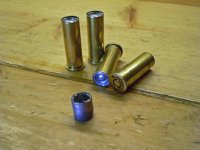. . . Buy a box of factory ammo with the velocity clearly marked on it. Fire some rounds across your chronograph and see what the resulting average is.
Factory ammo velocities are never OK for me. What was the barrel length used in their tests? What was the difference between the bullet diameter and the measured groove diameter? Barrel length can make a significant difference in velocities, so if you shoot a carbine and the factory uses a longer test barrel, it will appear your chronograph is not accurate.match what is stated on the box. Early Mauser 1898s, Krags, etc. with 30 " barrels and the ammo factory is using a 22" test barrels, how accurate will the printed box label be?
Second guessing properly set up chronographs is akin to not believing your compass. The most important piece of reloading equipment I own is my PACT. It measures everything I shoot across it. 22 Short to 22 LR, no problems. Keys are clean sensors, set it up properly and on a solid base, shoot level, follow instructions. I cannot tell you how many people shoot rifles across their chronograph that is 4 feet away from their muzzle and claim the equipment is junk, or don't bother to put on their sun screens, etc.
Companies that make chronograph equipment are trying their absolute best to assure accuracy. If you don't believe what you see on the screen, check the set-up. Trust your equipment or don't use it, but don't blame it.
Case in point for the benefit of using a chronograph was a trip to the range yesterday. I just bought a K38 Combat Masterpiece from 1951 and loaded up several different published rounds to test. One such load was just under a max load for a 148 grain HBWC. Published velocity using the powder company's online manual was 800 fps. Shot 2 rounds and the chronograph read over 1000 fps. Not wanting to shoot the rest of the loaded rounds, I went to empty the remaining 2 rounds and for some reason, the cylinder would not open. Had to take it home loaded ( thank god for my CCW). What I found was very troubling, a skirt had blown off the HBWC and lodged between the forcing cone of the barrel and the front of the cylinder. Another inch and the next shot would have caused quite a bit of commotion at the range at a minimum. Checked the loads after removing the bullets on the remaining rounds and found the exact right powder weights, so the rounds were properly loaded.
I have never taken a new loading recipe to the range without my chronograph and never will. Bottom line is trust your equipment, watch every shot result and be safe and secure with the knowledge gained.

